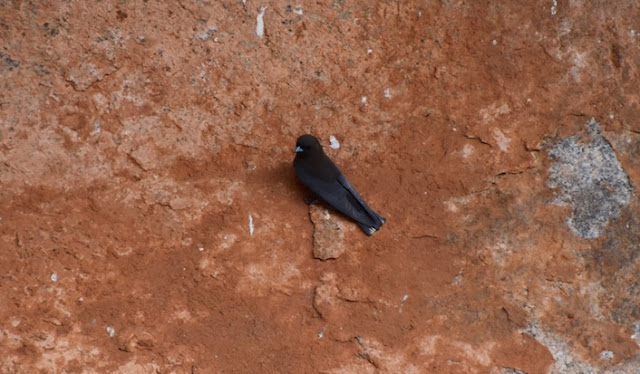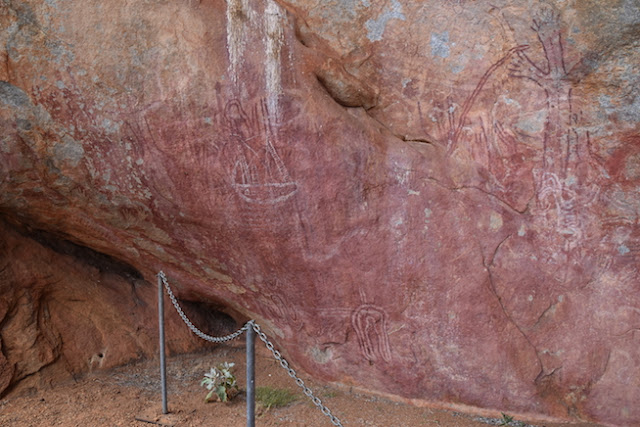Cue is a curious town , one formed in the gold rush , and still sustained by gold mining . Commercial mining is still carried out - old mines reopened and mined using new techniques . Casual prospecting here is huge , the caravan park in town is full of prospectors - some that have been here for 6 months - they have been doing this for the last 10 or more years . When the gold fever hits , it hits hard , but the people we’ve talked to have enjoyed being here , the commaradery is amazing , everyone is happy when someone finds a small nugget , but most finds are just small pieces , mind you there’s a lot of other finds - pick heads , tobacco tins , wire , and many other metallic objects .
There’s a steady procession out of the park in the morning , and a similar one in the afternoon .
Today we headed out to a ghost town - Big Bell . Big Bell was another gold mining town , it was gazetted in 1936 and peaked in 1954 with a population of 850 . It was built as a service town for the Big Bell Gold Mine , it had a train service to Cue , mail and air mail service , it’s own power plant , churches and many homes , a hotel that boasted the longest bar in Australia , and some shops . In 1955 the mine shutdown , and with that so did the town of Big Bell , houses were sold off and removed and the town stopped .
This is a windmill & tank & trough just outside town .
This is the remains of the once prospering art deco hotel .
There are only a couple of buildings remaining now - without roofs , lot’s of concrete slabs , some fences and lot’s of junk lying around - all within a stones throw from the operating Big Bell Mine .
After driving around the old streets we headed off to another attraction - Walga Rock . It’s a monolith - same as Ayers Rock - certainly not as big as Ayers Rock - this one is only 5klms around the base , and certainly not as high either , but still impressive . It also has some impressive aboriginal art work under an overhang on the side .
One of our first view of the rock was seeing large chunks of rock that have separated from the main rock , just sitting , waiting to slide down .
Entering the gate , we drove in about one kilometre to the fenced off artworks . Fly nets were in order , the flies were very friendly today . The rock has a different texture to Ayers Rock , a patch work type finish .
Water has stained the rock , leaving ribbons of colour .
Mud Swallows have built nests under the overhang , one of the birds was sitting against the wall above the artworks .
The artworks have been placed here over thousands of years , some years white has been used for painting , other years red - parts of the wall have a red tinge . One of the paintings here is of a boat with mast & rigging - many theories abound about the artist - some say it was a dutch sailor that the aborigines saved after being shipwrecked .
After some lunch , we walked up the rock for a great 360 degree view of the adjacent country , there are other large rocks nearby as well .
After coming back down , we then drove around the base of the rock . This is the other side of it .
We found a Bungarra - lizard - as we drove around , it stopped and checked us out .
Our last destination for today was Dalgaranga Crater - it was another 50 klms away , so away we went . The gravel roads were excellent , and wildflowers were becoming more frequent - some areas covered in pink , others yellow - the flowers & plants only growing about 3cm high .
As we turned onto the crater road , Lyn saw an area over to our right that was covered in flowers . The area turned out to be about 50 acres or more - absolutely stunning !!
From that we went to this - some contrast !!
One of the locals also paid us a fleeting visit .
Finally we turned up the track to the crater , and after another 4klms we arrived . Jumping out of the ute and expecting a walk to the crater , we were a little underwhelmed with the size of the crater that was just in front of us . It is 25m across and 5m deep and has a pole showing the point of impact . There’s a sign showing the amount of craters we have in Australia - we were standing at the SMALLEST !!
With that we headed into Mt Magnet , then back up to Cue , a round trip of nearly 250klms for the day .
Another good night’s sleep , and we headed out to a mine close to town to see the old mine office , it’s in the pictures above .
From there we went out Lakelands Rd and found a salt lake - Lake Austin . It was interesting as on one side of the road it was white , and on the other brown , making for interesting photos . I played with the drone a bit as well .
That’s it for Cue , here’s a map link : - https://drive.google.com/open?id=13gCjhajEj_ZcWlDVdkZQATLxUSu2Ym4Z&usp=sharing


































No comments:
Post a Comment